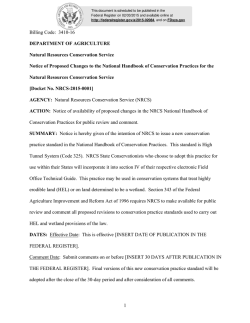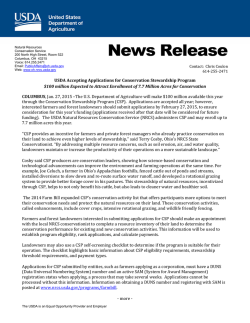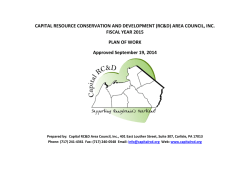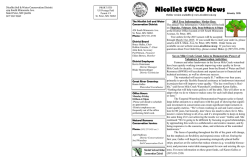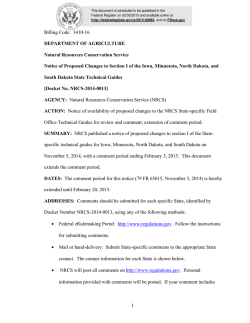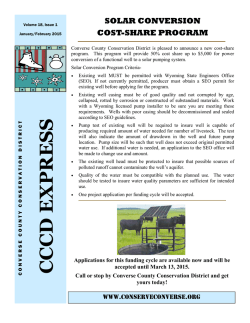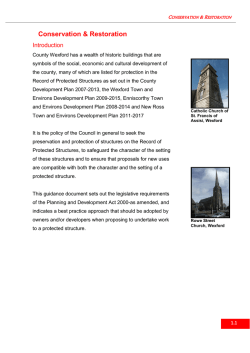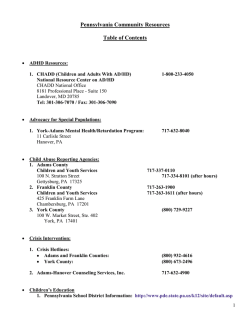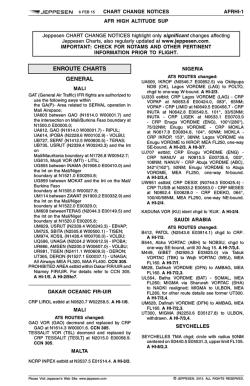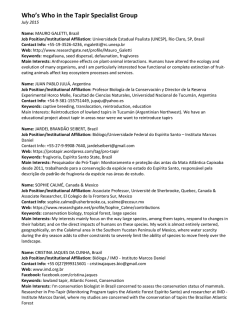
ACD draft Long Range Plan - Adams Conservation District
5-Year Plan (2015 to 2020) Adams Conservation District For More Information Contact: Cara Hulce, 509-659-1553, [email protected] Organization of the Adams Conservation District A political subdivision of the State of Washington – authorities, powers and structure contained in RCW 89.08. The Ritzville Conservation District was formed on 11/23/1951; the “Benge-Washtucna” District was formed on 11/25/1952. These two agencies consolidated into the Adams SWCD in 1963. The Lind area was annexed in 1964. In 1966 “8 townships” along the western edge of the county transferred to the Warden CD in anticipation of the arrival of the East High Canal in the Columbia Basin Project. In early 2000 Lincoln County released more Adams County lands to the current Adams CD region following a Lincoln County assessment providing the Adams Conservation District with approximately 900,000 acres of conservation responsibilities out of the total 1,219,665 Adams County Acres. Function of the Adams Conservation District To make available technical, financial and educational resources, whatever their source, and focus or coordinate them so that they meet the needs of the local land managers with conservation of soil, water and related natural resources. We Serve & Why The Adams Conservation District serves dryland crop producers, irrigated crop producers, and cattle ranchers occupying rangeland, as well as adjacent resource lands. The ACD focuses primarily on agricultural activities providing conservation protection or solutions for a quality resource base. Mission of the Adams Conservation District The Mission of the Adams Conservation District is to provide technical, financial, and educational assistance to landowners/operators to conserve natural resources. Vision of the Adams Conservation District Enhancing the natural environment through farming standard improvements and public education objectives by: o Gaining respect, trust, and rapport with producers, landowners, and the public; forming partnerships with them to meet their needs as well as preserve and improve our environment Better educating the public on resource concerns of ranchers and producers Voluntary participation (have a waiting list) of the public in district programs (workshops and financial assistance programs) Being known by the community as being prudent in resourcing revenue to fund projects Getting “dollars on the ground” by being financially sound Meeting and/or exceeding goals o Becoming a pioneer district in the adoption of minimal disturbance CRP take out and cropping systems; managed grazing allowed on CRP; better management of CRP take-out during drought years. Cutting wind erosion by 75% o Having a strong program of supporting pasture and range management resulting in rangelands in much better condition Continuing a robust program of installation of cross fencing and solar wells Replacing medusa head and skeleton weed in rangeland with good forage Values of the Adams Conservation District Preservation of natural resources through the installation of conservation practices and enhanced education objectives through leading edge technology. Natural Resource Data & Information: WRIA 34: Palouse Total Maximum Daily Load (TMDL) TMDLs describe the type, amount and sources of water pollution in a particular water body; they analyze how much the pollution needs to be reduced or eliminated to meet water quality standards; and they provide targets and strategies to control the pollution. http://www.ecy.wa.gov/programs/wq/tmdl/TMDLsbyWria/tmdl-wria34.html EPA water quality assessment Washington's Water Quality Assessment lists the water quality status for water bodies in the state. This assessment meets the federal requirements for an integrated report under Sections 303(d) and 305(b) of the Clean Water Act. The assessed waters are grouped into categories that describe the status of water quality. The 303(d) list comprises those waters that are in the polluted water category, for which beneficial uses– such as drinking, recreation, aquatic habitat, and industrial use – are impaired by pollution. http://www.ecy.wa.gov/programs/wq/303d/currentassessmt.html West Palouse Local Work Group: Session notes 2014 Lincoln and Adams County make up the West Palouse Local Work Group, which is a group of natural resource conservation agencies, organizations, and landowners who determine the resource concerns in the area. http://www.lincolncd.com/?page_id=121 NRCS: Priority resource concerns Local work group resource assessments provided a baseline of information that assisted in determining and ranking the statewide resource concerns. http://www.nrcs.usda.gov/wps/portal/nrcs/detail/wa/programs/financial/eqip/?cid=nrcs144p2_036280 Criteria for Selecting Conservation Priorities: Need o o o o o o o o Funding o o o o Location of the resource Whether the resource concern has been identified by partner agencies Locally wanted and needed Number of district residents impacted Acres treated and-area of the district impacted Feasibility of addressing the need Resource sustainability Amount of rainfall, soil type, frost zone of the area The cost and having personnel available to address the need Available funding sources to address the need (local, state, federal and/or private) Time required accomplishing Economically feasible Priority Natural Resource Conservation Needs & Geographic Areas, Measures of Success and Goals: Immediate Priority Natural Resource Issue Imminent: CRP Take-out areas o Educational materials discussing alternative management options for CRP takeout acres will be available by 2015 Develop CRP incentives to remain in pasture o All lands taken out of CRP that are intended to be cropped will have been direct seeded by 2016. Priority 1 Natural Resource Issues Wetlands o By 2020 the current area encompassing wetlands will be maintained at minimum or increased through constructed conservation practices Water Quality o By 2020 water quality parameters not currently meeting state standards in Cow Creek will be improved. By 2020 cropland soil erosion will be reduced by use of deep tillage or other practices By 2020 pasture soil erosion will be reduced by expanded use of retention structures, grass waterways, or other practices Domestic and urban wells (quality and quantity) o By 2015 ACD will provide test kits for domestic well owners Water Quantity (wells) o By 2020 ACD will locate resources to help deep well irrigators improve water efficiency Water availability for livestock o By 2020 ACD will locate resources to help livestock producers water livestock with the use of solar watering facilities and other water development practices Priority 2 Natural Resource Issues Soil erosion (wind &water) o By 2015 ACD will expand the program to install windbreak buffers. o By 2015 ACD will work with transportation agencies and others to install roadside buffers Weed infestations o By 2015 locate a grant for education and to reduce weed infestations o By 2017 ACD will promote test sites for medusa head weed control Direct seed education in low rainfall areas o By 2015 ACD will create a campaign to educate and promote direct seed Priority 3 Natural Resource Issues Range Condition o By 2016 ACD will have a public education program on sustainability o By 2017 ACD will promote rotational grazing for rangeland improvement Priority Geographic Areas: Imminent: CRP Take-out areas 1. Water Quantity: West side “deep well” irrigation circles areas 2. Water Quality: Cow Creek 3. Channeled Scablands (range condition) Information – Education Priorities, Measures of Success, and Goals: Information Education By April 2015, make the website a resource to producers and the public on resource issues Inform the public of available funds for improvement projects Continue K-12 outreach Continue the ACD newsletter and increase circulation Continue ACD booth at Wheatlands Communities Fair Increase district representation at organization meetings (cattlemen, direct seed, wheat growers, GWMA, etc) Develop a volunteer program to help assist with implementation projects and educate public on resource concerns. District Operations Board – o All 5 supervisor seats filled with active and engaged board members Staffing o o o o o Office o Funding o District Manager/Technician Bookkeeper Range Specialist (either on staff or outsourced through another district or other agency) As workload increases, evaluate staffing needs. Continuing education for district staff Repair and/or sell old building Seek partnerships with agencies & organizations (NRCS-RCPP TSP, WDFW, DNR, Ducks Unlimited, Pheasants Forever, DOE, DOT, WSCC, other conservation districts, Adams County, County Weed Board, etc) Milestones, Timeline & Actions Priority: CRP Take-out areas Measurable Goal: Educational materials discussing alternative management options for CRP takeout acres will be available in 2015 Milestones Work with NRCS and Palouse Rock Lake CD to develop materials Publish and distribute materials Timeline By March 12 Month Actions By March Priority: CRP Take-out areas Measurable Goal: All lands taken out of CRP that are intended to be cropped will have been direct seeded by 2016. Milestones Convene/attend growers meetings to plug direct seed options Send information to local publications Publish information on ACD and other associated websites Compile list of available custom seeders and/or drills available Seek funding to help on outreach and cost share Timeline Before 2015 growing season Before 2015 growing season Before 2015 growing season June 2015 Immediately 12 Month Actions Priority: Wetlands Measurable Goal: By 2020 the current area encompassing wetlands will be maintained at minimum or increased through constructed conservation practices Milestones Compile inventory of existing wetland resources Investigate opportunities to recharge wetlands during spring runoff time Contact WDFW, Ducks Unlimited, Pheasants Forever, NRCS, etc to help fund ACD efforts Create/use a wetland tracking mechanism Timeline December 2015 December 2015 12 Month Actions Immediately December 2015 Priority: Water Quality Measurable Goal: By 2020 water quality parameters not currently meeting state standards in Cow Creek will be improved. Milestones Reduce cropland soil erosion by use of deep tillage or other practices Timeline 2020 Reduce Pasture soil erosion by expanded use of retention structures, grass waterways, or other practices Encourage tree planting/grass waterways along water bodies and runoff areas For all above, put information on the ACD website 2020 Now Now 12 Month Actions Grower outreach Repair and advertise the sub-soiler for use by growers Investigate the use of eco-tiller by growers Investigate what other CDs and Extension are doing on this and partner Identify programs that will fund practices (NRCS, Ecology, WDFW, DOT, NGOs, etc) Grower outreach Identify high-runoff areas Identify programs that will fund practices (NRCS, Ecology, WDFW, BLM, DNR Priority: Domestic and urban wells (quality) Measurable Goal: By 2015 ACD will provide test kits for domestic well owners Milestones Contact County Health Department for test kits Work on outreach materials for well owners Timeline April 2015 12 Month Actions April 2015 Priority: Water Quantity (wells) Measurable Goal: By 2020 ACD will locate resources to help deep well irrigators improve water efficiency Milestones Work on identifying ag water conservation programs to help fund TA&FA for water use efficiency (NRCS, WSCC, Bonneville, Ecology, REAs, etc) Timeline Feb 2016 12 Month Actions Priority: Water availability for livestock Measurable Goal: By 2020 ACD will locate resources to help livestock producers water their livestock with the use of solar watering facilities and other water development practices Milestones Investigate programs for funding technical assistance and financial assistance Develop an ACD program and publicize it with the public and funders Timeline Feb 2015 12 Month Actions Priority: Soil erosion (wind & water) Measurable Goal: Milestones Timeline Expand the program to install 2015 windbreak buffers. Work with transportation 2015 agencies and others to install roadside buffers Investigate the purchase or partnering on a rotary subsoiler and stubble mower for the district to rent out Create campaign to educate 2015 and promote direct seed Priority: Weed infestations 12 Month Actions Measurable Goal: By 2015 locate a grant for education and to reduce weed infestations Milestones Timeline Partner with the county weed board for funding and outreach Partner with chemical companies April 2015 12 Month Actions Priority: Range Condition Measurable Goal: By 2017 ACD will promote rotational grazing for rangeland improvement Milestones Timeline Work with NRCS to acquire technical and financial assistance Develop a rotational grazing cost share program Develop a demonstration project on fertilizing or interseeding or aerial seeding. Feb 2016 12 Month Actions August of 2016 August of 2016 Staffing Needs (optional) District Manager/Technician Bookkeeper Range Specialist (either on staff or outsourced through another district or other agency) As workload increases, evaluate staffing needs. Continuing education for district staff Annual Budget Needs (optional) Budget needs will be finalized each year when the ACD board adopts its annual plan of work. Key Decision Makers (optional) Adams County Commissioners Adams County Weed Board Senator Mark Schoesler Representative Joe Schmick Representative Susan Fagan Governor Jay Inslee Congressman Dan Newhouse – Member, House Agriculture Committee Congresswoman Suzan DelBene – Member, House Agriculture Committee Congresswoman Cathy McMorris Rogers and Mike Poulson Senator Patty Murray Senator Maria Cantwell Jason Weller, Chief – Natural Resources Conservation Service Roylene Rides-at-the-Door, State Conservationist – NRCS Ann Swannack, District Conservationist – NRCS Dan Harwood, Manager – Palouse Rock Lake Conservation District Jennifer Boie, Manager – Palouse Conservation District Elsa Bowen, Manager – Lincoln Conservation District Mark Nielson, Manager – Benton and Franklin Conservation Districts Vicki Carter, Director and Ty Meyer, Production Ag Manager – Spokane Conservation District Washington Association of Wheat Growers Washington Cattlemen’s Association Aaron Esser, Adams County Director – WSU Cooperative Extension Pacific Northwest Direct Seed Association Columbia Basin Groundwater Management Area Jeff McCreary, PNW Conservation Director – Ducks Unlimited Larry Yockey, Pheasants Forever Mark Clark, Executive Director – Washington State Conservation Commission Todd Welker, Southeast Region Manager – Washington Department of Natural Resources Jim Brown, North Central Regional Director, Washington Department of Fish and Wildlife Grant Pfeifer, Eastern Regional Director – Washington Department of Ecology Keith Metcalf, Eastern Regional Director – Washington Department of Transportation Washington Conservation Districts assisting land managers with their conservation choices
© Copyright 2025
